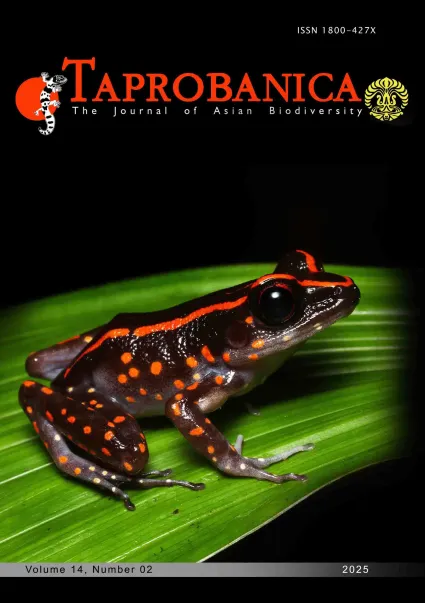

v14i2.394
Volume 14 | Number 2 | November 2025
Short Note
eISSN: 1800-427X (online)
DOI:10.47605/tapro.v14i2.394
Submitted date: 28 December 2024
Accepted date: 21 April 2025
Published date: 28 November 2025
Pp. 334–336.
White-haired Trachypithecus cristatus on Gunung Kubing, Belitung
S.S. Azyati, D.A. Rahman, Diardi, A. Yuliansyah, A. Darmawan, H.I. Maulahila & P. Rianti
*Corresponding author. E-mail: pujirianti@apps.ipb.ac.id
Leucism differs from albinism because it does not entirely inhibit melanin production but reduces pigmentation in some areas. It is often linked to low genetic diversity caused by geographic isolation and inbreeding. Leucism is a rarely reported phenomenon in primates. Reported cases in Asia include leucistic individuals of Trachypithecus obscurus (dusky leaf monkey) in Langkawi, Malaysia and Semnopithecus vetulus (purple-faced langur) in Sri Lanka. In the near kampung Bilit, Kinabatangan, Sabah, Lhota et al. (2022) report Trachypithecus cristatus (silvery langur) with a specific reduction in pigmentation, leading to uneven off-white patches appearing on different areas of the body. A notable historical report describes a silvery langur with red hair in North Borneo, suggesting that hair colour anomalies have been occurring sporadically across langur populations.
Section Editor: Vincent Nijman
DOI:10.47605/tapro.v14i2.394
Submitted date: 28 December 2024
Accepted date: 21 April 2025
Published date: 28 November 2025
Pp. 334–336.
White-haired Trachypithecus cristatus on Gunung Kubing, Belitung
S.S. Azyati, D.A. Rahman, Diardi, A. Yuliansyah, A. Darmawan, H.I. Maulahila & P. Rianti
*Corresponding author. E-mail: pujirianti@apps.ipb.ac.id
Leucism differs from albinism because it does not entirely inhibit melanin production but reduces pigmentation in some areas. It is often linked to low genetic diversity caused by geographic isolation and inbreeding. Leucism is a rarely reported phenomenon in primates. Reported cases in Asia include leucistic individuals of Trachypithecus obscurus (dusky leaf monkey) in Langkawi, Malaysia and Semnopithecus vetulus (purple-faced langur) in Sri Lanka. In the near kampung Bilit, Kinabatangan, Sabah, Lhota et al. (2022) report Trachypithecus cristatus (silvery langur) with a specific reduction in pigmentation, leading to uneven off-white patches appearing on different areas of the body. A notable historical report describes a silvery langur with red hair in North Borneo, suggesting that hair colour anomalies have been occurring sporadically across langur populations.
Section Editor: Vincent Nijman
- List of Articles & Contents





